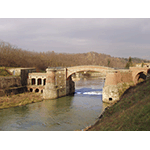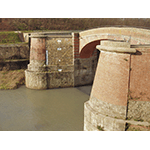"Chiusa dei Monaci" Sluice
The "Chiusa dei Monaci" sluice was built around 1151 by the friars of the monastery of Santa Flora and Lucilla of Arezzo as a weir on the Canale Maestro (north of Arezzo), with the function of regulating the outflow of waters from the marshland of the Valdichiana to the River Arno. In 1388, the level of the sluice threshold was lowered in the attempt to improve water outflow. It became one of the main structures in regulating the waters of the Chiana, but between 1547 and 1607 it was overrun by floods at least ten times. To improve the conditions of the swamp area, it was planned to lower the threshold again in the late 16th century. This intervention, however, encountered the opposition of the Florentines, worried that the waters of the Chiana that flowed into the Arno would increase the risk of floods in Florence. In 1635, under commission to the Florentines, Enea Gaci from Castiglione elaborated a project which, among other interventions, provided for the destruction of the sluice, but this was never realised due to the opposition of Evangelista Torricelli.
New works on the sluice were planned and, in several cases, carried out between the 18th and 19th centuries. In the mid 18th century, Grand Duke Peter Leopold of Lorraine sent Leonardo Ximenes to Valdichiana in order to develop a reclamation project. Ximenes suggested that the level of the sluice be lowered even more, but this time too, the project was not realised, so as to avoid compromising the navigability of the Canale Maestro. The same type of intervention was suggested by Vittorio Fossombroni in the late 18th century. In 1838, Alessandro Manetti again proposed to lower the sluice by more than three metres and to build a drain beside it. Today, the structure testifies to the Lorraine intervention in Valdichiana, and is part of the "Chiusa dei Monaci" Park, located at the end of the Canale Maestro della Chiana.
****************************
Texts by Graziano Magrini
English translation by Victor Beard
Last update 04/gen/2008





